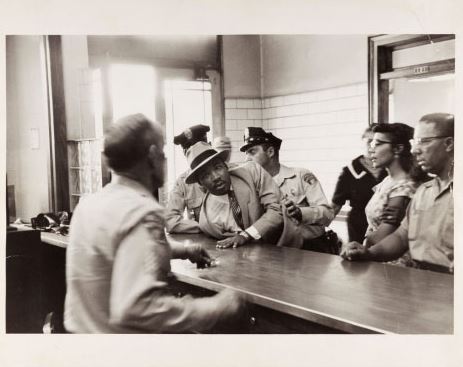
Charles Moore/Ryerson Image Centre/Black Star
"The Arrest of Dr. Martin Luther King." Montgomery, Ala., 1958.
Before Henry Luce could publish his first picture-packed issue of Life magazine, he first had to figure out how to get enough photographs. In the mid-1930s, most people thought there were simply not enough America photographers to supply the more than 200 images needed for each issue of the magazine.
But, as Michael Torosian recounts, the Black Star photo agency had the capacity to do so. With a worldwide network of photojournalists, the fledgling agency struct a deal with Life that ensured its success and that of the magazine.
"In their first five years of publication," Mr. Torosian estimated, "Life reproducted more than 3,000 pictures credited to Black Star."
A striking selection of those images commissioned or brokered by the agency has recently been published in "Black Star," a limited edition book from Lumiere Press with text by Mr. Torosian. The book details how Black Star sated the ravenous appetites of picture magazines like Life that were so extraordinarily popular and influential in shaping public discourse and values in mid-20th-century America.
Black Star was established in the early 1930s by Jewish emigres, Kurt Safranski, Ernest Mayer, and Kurt Kornfield, who were innovators in Germany's picture press and publishing world and fled from the Nazis. Their New York-based company commissioned and brokered the use of photographs that documented important events, the comings and goings of notables, and human interest stories.

Max Pohly/Ryerson Image Centre/Black Star
"First World War." Russia, circa 1916.
Black Star's earliest clients, which also included Look, The Saturday Evening Post, and Collier's, understood the efficiency and popularity of photographic images and shrewdly exploited their power. In later decades, Black Star photographers, including W. Eugene Smith, Philippe Halsmann, and Charles Moore, shot many of the indelible images of World War II, the cold war, civil rights movement, and the social and cultural tumult of the 1960s and 1970s.
But as TV news undermined the novelty and market for weekly magazines, the photo agency business needed to evolve. And under the leadership of Howard Chapnick, who directed Black Star from 1964 to the 1980s, it did. Mr. Chapnick not only championed and helped to rethink photojournalism for a new era, but broadened the agency's mission. News photography remained central to it, but Black Star (and other agencies like it, like Magnum) began to supply more and more images, and color ones in particular, to the deep-pocketed corporate clients who paid handsomely to use photography differently, to burnish their public image and fill the pages of lavish annual reports.

Alexander/Ryerson Image Centre/Black Star
"Jean Cocteau With Portrait by Picasso." France, circa 1930.
The first generation of Black Star's principals was revered in the field, and so was Mr. Chapnick, whose charisma was legendary. "He was a friendly man, a curious man," said Robert Pledge, a competitor and ultimately a friend of Mr. Chapnick's, who led both the Gamma and Contact agencies. "He transitioned from great tradition of picture magazines to an era of smaller formatted newsweeklies and adjusted remarkable well, taking risks, and nurturing a new generation of dynamic photographers," Mr. Pledge said.
That group included James Nachtway, twin brothers Peter and David Turnley, and Christopher Morris, who started out as a Black Star intern. Mr. Morris, who has become an award-winning photojournalist, is among the founders of the photo agency VII. As he succinctly put it, "Howard was instrumental to who I am today."
Founded in the pre-digital era, photo agencies inevitable built up huge archies that began costly to maintain. By the late 1980s, Black Star had stockpiled about one million black-and-white prints and 10 million color transparencies. And while a small percentage of those archival images can be repurposed and resold - through licensing for nostalgic ads, books or online - most cannot, since old news, even if it's photographic, is old news. That means many archives wind up being returned to the individual photographers or stored, which can be expensive. Sometimes photographs just got thrown away.
Rather than endure that ignominious fate, Black Star's vast archives were saved thanks to the generosity of an anonymous donor who helped Ryerson University in Toronto acquire 300,000 vintage black-and-white prints. Now, and somewhat ironically, an iPad-sized, luxuriously produced book tells their story. In it, in addition to learning about Black Star's history, is a reminder of the power and legacy that photographs embody as three-dimensional and material objects.
If anything, they show that there is indeed life after Life.

Ralph Crane/Ryerson Image Centre/Black Star
Untitled. California, circa 1950.
